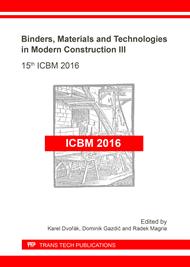[1]
R. Kumara, B. Bhattacharjee, B, in: Porosity, Pore Size Distribution and in Situ Strength of Concrete, Cement and Concrete Research 33(1), (2003), p.155–164.
DOI: 10.1016/s0008-8846(02)00942-0
Google Scholar
[2]
C. S. Poon, S. C. Kou, L. Lam, in: Use of Recycled Aggregates in Molded Concrete Bricks and Blocks, Construction and Building Materials 16(5), (2002), p.281–289.
DOI: 10.1016/s0950-0618(02)00019-3
Google Scholar
[3]
C. S. Poon, S. C. Kou, H. Wan, M. Etxeberria, in: Properties of Concrete Blocks Prepared with Low Grade Recycled Aggregates, Waste Management 29(8), (2009), p.2369–2377.
DOI: 10.1016/j.wasman.2009.02.018
Google Scholar
[4]
C. S. Poon, D. Chan, in: Paving Blocks Made with Recycled Concrete Aggregate and Crushed Clay Brick, Construction and Building Materials 20(8), (2006), p.569–577.
DOI: 10.1016/j.conbuildmat.2005.01.044
Google Scholar
[5]
O. Gencel, C. Ozel, F. Koksal, E. Erdogmus, G. Martínez-Barrera, V. Brostow, in: Properties of Concrete Paving Blocks Made with Waste Marble, Journal of Cleaner Production 21(1), (2012), p.62–70.
DOI: 10.1016/j.jclepro.2011.08.023
Google Scholar
[6]
J. Šelih, in: Performance of Concrete Exposed to Freezing and Thawing in Different Saline Environments, Journal of Civil Engineering and Management 16(2), (2010), p.306–311.
DOI: 10.3846/jcem.2010.35
Google Scholar
[7]
B. Di Sabatino, D. Gimeno, C. Pace, in: Synthesis and characterization of Na-X, Na-A and Na-P zeolites andhydroxysodalite from metakaolinite. ClayMinerals (46), (2011), p.339–354.
DOI: 10.1180/claymin.2011.046.3.339
Google Scholar
[8]
D. Vaičiukynienė, V. Vaičiukynas, V. Vaitkevičius, L. Dirsė, in: The Use of Hydrosodalite in Hydraulics Cement Structures, in The 5th International Scientific Conference, (2011).
Google Scholar
[9]
D. Nagrockienė, G. Girskas, G. Skripkiūnas, in: Cement Freezing–Thawing Resistance of Hardened Cement Paste with Synthetic Zeolite, Construction and Building Materials 66, (2014), pp.45-52.
DOI: 10.1016/j.conbuildmat.2014.05.025
Google Scholar
[10]
C. S. Poon, S. C. Lam, Z.S. Kou, A. Lin, in: Study on the Hydration Rate of Natural Zeolite Blended Cement Pastes, Construction and Building Materials 13(8), (1999), p.427–432.
DOI: 10.1016/s0950-0618(99)00048-3
Google Scholar
[11]
B. Yılmaza, A. Ucarb, B. Oteyakab, V. Uza, in: Properties of Zeolitic Tuff (Clinoptilolite) Blended Portland Cement, Building and Environment 42(11), (2007), p.3808–3815.
DOI: 10.1016/j.buildenv.2006.11.006
Google Scholar
[12]
K. A. Kallipi, in: Pore structure of cement-based materials. Testing, interpretation and requirements, Modern concrete technology series 12, (2006), p.1–33.
Google Scholar
[13]
P. K. Mehta, P. J. Monteiro, Concrete structure, properties and materials, Prentice-Hall, Inc., Englewood Cliff, New jersey, Second Edition. (1993), 548 p.
Google Scholar
[14]
B. Zuber, J. Marchand, in: Modeling the deterioration of hydrated cement systems exposed to frost action. Part 1: description of the mathematical model, Cement and Concrete Research (30), (2000), p.1929–(1939).
DOI: 10.1016/s0008-8846(00)00405-1
Google Scholar


